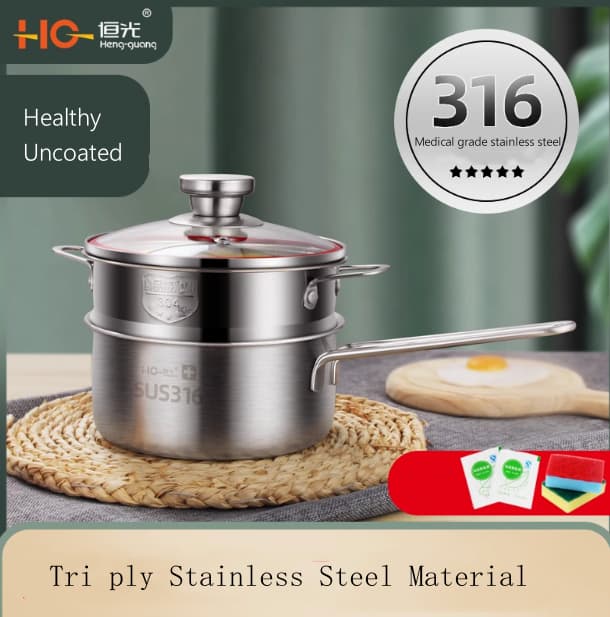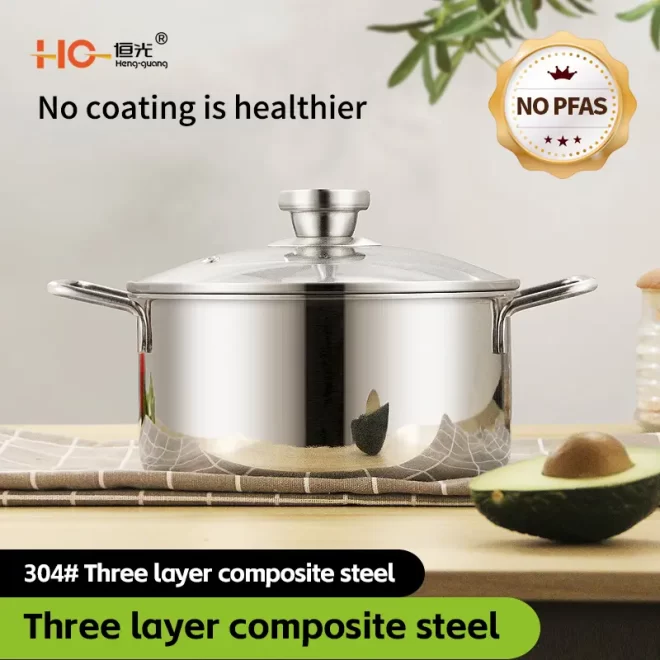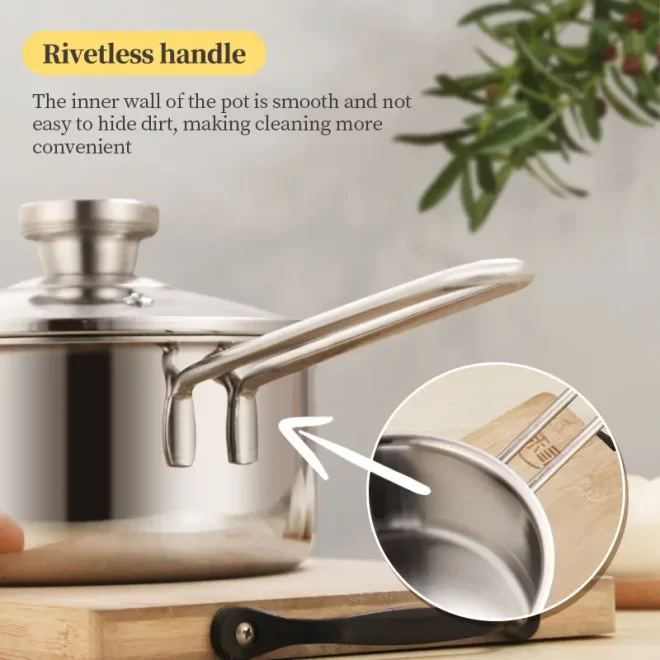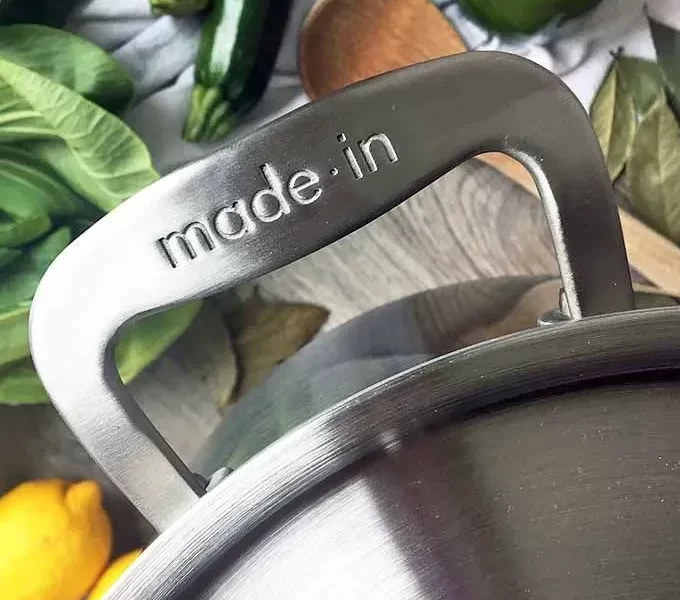
For years, we can conclude that cookware certification standards aren’t just paperwork—they are design drivers. For manufacturers, brands, and global buyers, a cookware certification standard determines which materials, joining methods, finishes, and ergonomics will pass muster in demanding markets.
From the alloy you choose to the thickness profile of a pan, certification requirements (ISO, EN, LFGB, FDA, and others) push cookware design toward safer, more durable, and more marketable products.
This blog of Hengguang, a top stainless steel kitchenware manufacturer, explains the concrete ways standards shape modern stainless steel cookware—and why buyers should treat compliance as a competitive advantage.
Material Selection: Chemistry Chosen to Pass Tests
The first and most visible impact of any cookware certification standard is on material choice. Regulations and test protocols set limits on metal migration, corrosion resistance, and mechanical performance. As a result:
- Cookware manufacturers moved from undefined “stainless” to named grades—304 (18/8, 18/10) and 316 for food-contact surfaces, and 430 or specially engineered ferritic alloys for magnetic bases.
- Certifications require documented alloy chemistry (MTRs) and migration testing; this forces suppliers to control feedstock quality and to avoid “economy” alloys that fail salt-spray or heavy-metal tests.
- For coastal or industrial markets, 316 with molybdenum becomes a design requirement rather than an option, because chloride resistance testing (common in EN-based or LFGB protocols) flags inferior alloys.
In short, the standard tells you what metal will pass—and the design follows.
Structural Design: Thickness, Ply, and Bonding are Engineered to Verify
Cookware certification standards push more than metallurgy—they force structural engineering decisions:
- Durability and thermal tests used in certification (thermal shock, warp, handle torque) drive minimum wall and base thickness specifications. Thin, cheap pans may look fine initially, but fail cycle and warp tests used by many standards. Manufacturers respond by specifying clad constructions (tri-ply, five-ply) and controlled gauge tolerances.
- EN and ISO test suites for cookware require secure handle attachments and rivet strength; therefore, handle geometry, rivet count, and welding procedures are engineered to meet torque and impact tests.
- Bonding standards (for fully-clad cookware) influence the manufacturing route: roll-bonded sheets with validated bond strength are preferred over weaker laminations that could delaminate under certification cycling.
Result: certified cookware tends to be more robust, with measured ply structures and validated bonding that reduce returns and warranty claims.
Surface Treatment & Finishing: Passivation, Polish, and Coating Choices
Surface finish plays dual roles: it affects both hygiene and compliance. Cookware certification standard tests often include migration checks and surface cleanliness requirements, which translate into design decisions:
- Passivation and electropolishing become standard post-processing steps. For the purpose of enhancing corrosion resistance, passivation is the first priority. On the other hand, electropolishing can improve the surface smoothness of cookware. A smooth, passive chromium-oxide surface resists leaching and passes migration tests more readily than a rough, unpassivated surface.
- For coated products, certification standards force documented coating chemistry and adhesion testing—PFOA/PFOS bans and coating migration tests (required by many markets) push manufacturers toward PFOA-free coatings or to hybrid textured stainless solutions that reduce exposed coating area.
- Finishes are specified in measurable terms (surface roughness Ra values, gloss units) in product specifications, so the same surface that passed lab tests is what reaches buyers.
Kitchenware suppliers plan finishes to pass tests—and to make maintenance and sanitation predictable in real kitchens.
Ergonomics, Safety, and Usability: Testing Breeds Practical Innovation
Safety tests in cookware certification standards cover not only materials but also human factors:
- Handle heat-transfer tests push kitchenware wholesalers toward hollow or insulated handle architectures and the use of silicone grips or heat breaks. The result is cookware that is safer to handle during certification heat cycles.
- Lid and rim tests (sealing, steam venting, handle retention) drive lid design refinement for safe, repeatable use in commercial kitchens.
- Stability and anti-tip tests encourage broader bases or lower centers of gravity when the standard requires stability checks.
These ergonomics-driven changes are born of test protocols—and they improve everyday usability for chefs and consumers.
Sustainability and Lifecycle Thinking: Standards Influence Material Circularity
Modern cookware certification standards increasingly intersect with sustainability metrics. ISO 14001 and lifecycle assessment (LCA) expectations nudge design choices:
- Manufacturers select recyclable stainless alloys and reduce mixed-material joins that complicate recycling.
- Longer-lasting constructions (tri-ply vs. single-clad) are promoted because they decrease replacement frequency—a factor considered in many procurement and resale channels.
- Packaging and transport considerations (mandated by some retailers) influence how cookware is nested, protected, and labeled for lower environmental cost.
The upshot: compliance now often implies better environmental performance as well.
Market Trust: Certification as a Commercial Signal
For buyers and distributors, certifications are not merely legal boxes to tick—they are commercial levers:
- Retail chains and foodservice groups require documented evidence (LFGB/FDA/Safety tests, MTRs, salt-spray results) to accept new SKUs. A product that carries a recognized cookware certification standard clears procurement faster and faces fewer customs or retail rejections.
- Certified products reduce risk—fewer recalls, fewer customer complaints, and lower insurance exposure. That risk reduction converts into lower procurement friction and better margins for brands that can show test reports per batch.
- From a marketing standpoint, certification badges justify premium positioning and support B2B sales pitches to hotels, caterers, and health-focused retailers.
Put simply: design that meets standards sells better.
Conclusion:
Cookware certification standard is not an obstacle; it’s an engineering brief for manufacturers, and it benefits consumers as well. The cookware certification standard landscape—material migration limits, thermal and mechanical cycling, human-safety tests, and sustainability criteria—has driven measurable improvements in stainless steel cookware design: better alloys, engineered bonding, validated finishes, and safer ergonomics.
For global buyers, choosing suppliers who build to standard-driven specifications is the fastest route to consistent quality, easier market access, and sustainable brand growth. Design to pass the test—and you’ll build products the market trusts.
About Hengguang
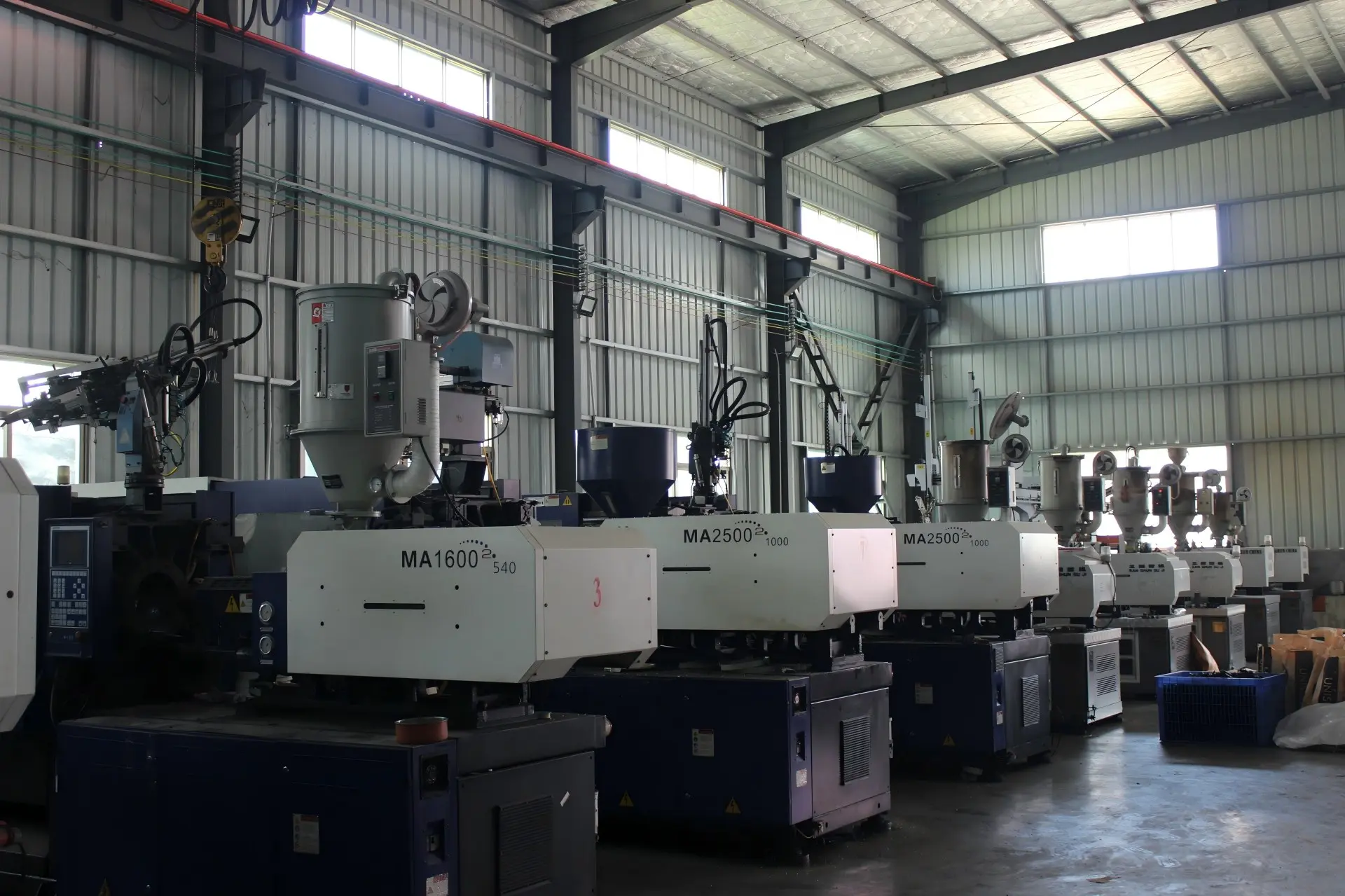
Hengguang, a top kitchenware manufacturer, is a reliable partner for premium cookware, supplying wholesale stainless steel cookware and offering custom stainless steel cookware solutions for global buyers.
We possess our own tri-ply stainless steel discs factory, therefore our tri-ply stainless steel cookware will be much more competitive than that of our rivals. At Hengguang, we are able to deliver consistent quality, competitive pricing, and fast fulfillment for brands that want long-lasting performance.
